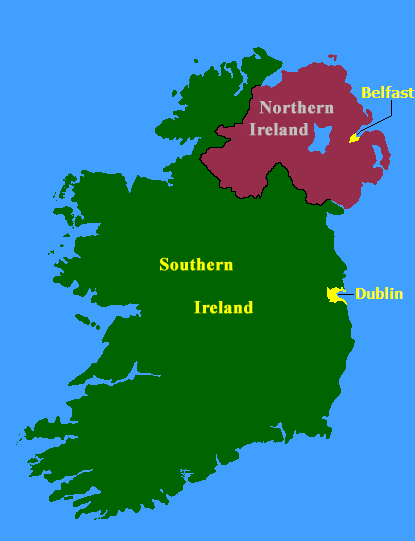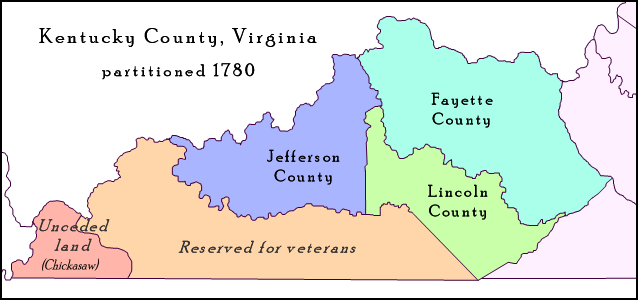|
Fayette County, Virginia
Fayette County, Virginia has existed twice in the U.S. state of Virginia's history. Formed in 1780, and 1831, respectively, both counties were named in honor of the Marquis de Lafayette, who had played a key role assisting the Continental Army during the American Revolutionary War, and each was separated from Virginia due to the creation of a new state, partitioned in accordance with Article IV, Section 3, Clause 1 of the United States Constitution. The two counties continued in existence as: * Fayette County, Kentucky, separated when Kentucky was admitted to the Union in 1792. * Fayette County, West Virginia, separated when West Virginia was admitted to the Union in 1863. See also * Former counties, cities, and towns of Virginia Former counties, cities, and towns of Virginia are those that existed within the English Colony of Virginia or, after statehood, the Commonwealth of Virginia, and no longer retain the same form within its boundaries. The settlements, towns, and ... ... [...More Info...] [...Related Items...] OR: [Wikipedia] [Google] [Baidu] |
Virginia
Virginia, officially the Commonwealth of Virginia, is a state in the Mid-Atlantic and Southeastern regions of the United States, between the Atlantic Coast and the Appalachian Mountains. The geography and climate of the Commonwealth are shaped by the Blue Ridge Mountains and the Chesapeake Bay, which provide habitat for much of its flora and fauna. The capital of the Commonwealth is Richmond; Virginia Beach is the most-populous city, and Fairfax County is the most-populous political subdivision. The Commonwealth's population was over 8.65million, with 36% of them living in the Baltimore–Washington metropolitan area. The area's history begins with several indigenous groups, including the Powhatan. In 1607, the London Company established the Colony of Virginia as the first permanent English colony in the New World. Virginia's state nickname, the Old Dominion, is a reference to this status. Slave labor and land acquired from displaced native tribes fueled the ... [...More Info...] [...Related Items...] OR: [Wikipedia] [Google] [Baidu] |
County (United States)
In the United States, a county is an administrative or political subdivision of a state that consists of a geographic region with specific boundaries and usually some level of governmental authority. The term "county" is used in 48 states, while Louisiana and Alaska have functionally equivalent subdivisions called parishes and boroughs, respectively. The specific governmental powers of counties vary widely between the states, with many providing some level of services to civil townships, municipalities, and unincorporated areas. Certain municipalities are in multiple counties; New York City is uniquely partitioned into five counties, referred to at the city government level as boroughs. Some municipalities have consolidated with their county government to form consolidated city-counties, or have been legally separated from counties altogether to form independent cities. Conversely, those counties in Connecticut, Rhode Island, eight of Massachusetts's 14 counties, and Alaska ... [...More Info...] [...Related Items...] OR: [Wikipedia] [Google] [Baidu] |
Marquis De Lafayette
Marie-Joseph Paul Yves Roch Gilbert du Motier, Marquis de La Fayette (6 September 1757 – 20 May 1834), known in the United States as Lafayette (, ), was a French aristocrat, freemason and military officer who fought in the American Revolutionary War, commanding American troops in several battles, including the siege of Yorktown. After returning to France, he was a key figure in the French Revolution of 1789 and the July Revolution of 1830. He has been considered a national hero in both countries. Lafayette was born into a wealthy land-owning family in Chavaniac in the province of Auvergne in south central France. He followed the family's martial tradition and was commissioned an officer at age 13. He became convinced that the American revolutionary cause was noble, and he traveled to the New World seeking glory in it. He was made a major general at age 19, but he was initially not given American troops to command. He was wounded during the Battle of Brandywine but still m ... [...More Info...] [...Related Items...] OR: [Wikipedia] [Google] [Baidu] |
American Revolutionary War
The American Revolutionary War (April 19, 1775 – September 3, 1783), also known as the Revolutionary War or American War of Independence, was a major war of the American Revolution. Widely considered as the war that secured the independence of the United States, fighting began on April 19, 1775, followed by the Lee Resolution on July 2, 1776, and the Declaration of Independence on July 4, 1776. The American Patriots were supported by the Kingdom of France and, to a lesser extent, the Dutch Republic and the Spanish Empire, in a conflict taking place in North America, the Caribbean, and the Atlantic Ocean. Established by royal charter in the 17th and 18th centuries, the American colonies were largely autonomous in domestic affairs and commercially prosperous, trading with Britain and its Caribbean colonies, as well as other European powers via their Caribbean entrepôts. After British victory over the French in the Seven Years' War in 1763, tensions between the motherland and he ... [...More Info...] [...Related Items...] OR: [Wikipedia] [Google] [Baidu] |
Partition (politics)
In politics, a partition is a change of political borders cutting through at least one territory considered a homeland by some community.Brendan O'LearyDEBATING PARTITION: JUSTIFICATIONS AND CRITIQUES Arguments for *historicist – that partition is inevitable, or already in progress * last resort – that partition should be pursued to avoid the worst outcomes (genocide or large-scale ethnic expulsion), if all other means fail * cost–benefit – that partition offers a better prospect of conflict reduction than the if existing borders are not changed * better tomorrow – that partition will reduce current violence and conflict, and that the new more homogenized states will be more stable * rigorous end – heterogeneity leads to problems, hence homogeneous states should be the goal of any policy Arguments against * national territorial unity will be lost * bi-nationalism and multi-nationalism are not undesirable * the impossibility of a just partition * difficult in de ... [...More Info...] [...Related Items...] OR: [Wikipedia] [Google] [Baidu] |
New States
New states may refer to: Creating new sovereign states (countries) *List of proposed state mergers to create new sovereign states *Lists of active separatist movements *List of historical separatist movements Creating new administrative subdivisions within countries *51st state, possible new states in the United States *List of U.S. state partition proposals *New states of Germany, five German states recreated in 1990 *List of proposed states of Australia *List of proposed provinces and territories of Canada *List of proposed states and territories of India See also *Estado Novo (other) *State (other) *New (other) *New Land (other) * New Country (other) *New areas of the People's Republic of China (special economic new urban zones) *New Territories, Hong Kong, China *New Territory, Texas New Territory is a master-planned community within the city of Sugar Land, Texas, United States. It was formerly a census-designated place (CDP) and ... [...More Info...] [...Related Items...] OR: [Wikipedia] [Google] [Baidu] |
United States Constitution
The Constitution of the United States is the Supremacy Clause, supreme law of the United States, United States of America. It superseded the Articles of Confederation, the nation's first constitution, in 1789. Originally comprising seven articles, it delineates the national frame of government. Its first three articles embody the doctrine of the separation of powers, whereby the federal government of the United States, federal government is divided into three branches: the United States Congress, legislative, consisting of the bicameralism, bicameral United States Congress, Congress (Article One of the United States Constitution, Article I); the Federal government of the United States#Executive branch, executive, consisting of the President of the United States, president and subordinate officers (Article Two of the United States Constitution, Article II); and the Federal judiciary of the United States, judicial, consisting of the Supreme Court of the United States, Supreme C ... [...More Info...] [...Related Items...] OR: [Wikipedia] [Google] [Baidu] |
Fayette County, Kentucky
Fayette County is located in the central part of the U.S. state of Kentucky. As of the 2020 census, the population was 322,570, making it the second-most populous county in the commonwealth. Its territory, population and government are coextensive with the city of Lexington, which also serves as the county seat. Fayette County is part of the Lexington–Fayette, KY Metropolitan Statistical Area. History Fayette County—originally Fayette County, Virginia—was established by the Virginia General Assembly in June 1780, when it abolished and subdivided Kentucky County into three counties: Fayette, Jefferson and Lincoln. Together, these counties and those set off from them later in that decade separated from Virginia in 1792 to become the Commonwealth of Kentucky. Originally, Fayette County included land which makes up 37 present-day counties and parts of 7 others. It was reduced to its present boundaries in 1799. The county is named for the Marquis de LaFayette, who came to ... [...More Info...] [...Related Items...] OR: [Wikipedia] [Google] [Baidu] |
Fayette County, West Virginia
Fayette County is a county in the U.S. state of West Virginia. As of the 2020 census, the population was 40,488. Its county seat is Fayetteville. It is part of the Beckley, WV Metropolitan Statistical Area in Southern West Virginia. History Fayette County—originally Fayette County, Virginia—was created by the Virginia General Assembly in February 1831, from parts of Greenbrier, Kanawha, Nicholas, and Logan counties. It was named in honor of the Marquis de la Fayette, who had played a key role assisting the Continental Army during the American Revolutionary War. The second Virginia county so named, it was among the 50 counties which Virginia lost when West Virginia was admitted to the Union as the 35th state in 1863, during the American Civil War. The earlier Fayette County, Virginia existed from 1780 to 1792, and was lost when Kentucky was admitted to the Union. Accordingly, in the government records of Virginia, there will be listings for Fayette County from 178 ... [...More Info...] [...Related Items...] OR: [Wikipedia] [Google] [Baidu] |
Former Counties, Cities, And Towns Of Virginia
Former counties, cities, and towns of Virginia are those that existed within the English Colony of Virginia or, after statehood, the Commonwealth of Virginia, and no longer retain the same form within its boundaries. The settlements, towns, and administrative units discussed here ceased to exist in a number of ways. A number of smaller settlements became extinct due to loss of population. In time, others changed names, ascended to higher levels (or occasionally, descended to lower levels) of autonomy, or were occasionally annexed by larger nearby units. At a higher level, large areas of Virginia were split off to form new states, transferred as state boundaries were clarified, or came under the administration of the federal government. , Virginia had 95 counties, 38 independent cities, and 190 incorporated towns. There are also hundreds of unincorporated places in Virginia with their own identities. History English settlement After the European discovery of North America in th ... [...More Info...] [...Related Items...] OR: [Wikipedia] [Google] [Baidu] |







